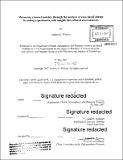| dc.contributor.advisor | John B. Southard. | en_US |
| dc.contributor.author | Wickert, Andrew David | en_US |
| dc.contributor.other | Massachusetts Institute of Technology. Department of Earth, Atmospheric, and Planetary Sciences. | en_US |
| dc.date.accessioned | 2018-03-27T14:19:23Z | |
| dc.date.available | 2018-03-27T14:19:23Z | |
| dc.date.copyright | 2007 | en_US |
| dc.date.issued | 2008 | en_US |
| dc.identifier.uri | http://hdl.handle.net/1721.1/114366 | |
| dc.description | Thesis: S.B., Massachusetts Institute of Technology, Department of Earth, Atmospheric, and Planetary Sciences, June 2008. | en_US |
| dc.description | Cataloged from PDF version of thesis. "31 May 2007." | en_US |
| dc.description | Includes bibliographical references (pages 125-128). | en_US |
| dc.description.abstract | We quantify the mobility of alluvial river channels in order to better understand the relationship between channel mobility and fluvial environment. We analyze five analog experiments, performed between 2002 and 2007 at the Saint Anthony Falls Laboratory, for area-based change in river-channel plan form with time. These experiments isolate the effects of (1) sediment input and deposition, (2) base-level, and (3) bank cohesion on channel mobility. (1) In experimental deltaic environments with aggradation and sea-level rise in equilibrium, aggradation rates scale non-linearly with channel mobility. The channels in the experiment with the higher aggradation rate move more rapidly overall, but the channels in the experiment with slower aggradation are more mobile when both experiments are scaled by their respective aggradation rates. Lower aggradation rates result in lower slopes, causing the flow to be shallower and broader, and for more deposition to occur. These low slopes result in lower Froude number, allowing the formation of flow-depth-high ripples that divert the flow. (2) We study experiments in which base-level change was slow, rapid, and intermediate in terms of average channel mobility when base-level is constant. Channels in an experimental basin with rapid (12.2 mm/hr) aggradation are three times as mobile during base-level rise as during base-level fall. Channels in a cohesive delta experiment (producing significantly lower channel mobility) are 1.5 times as mobile during slow base-level rise (0.237 mm/hr) as during steady base level. Base-level change that is slow on an average channel mobility timescale has little to no influence on channel mobility. (3) Channels in an experimental system of noncohesive sediment are 6.5 times as mobile as channels with alfalfa (Medicago sativa) planted in the flume. | en_US |
| dc.description.statementofresponsibility | by Andrew D. Wickert. | en_US |
| dc.format.extent | 128 pages | en_US |
| dc.language.iso | eng | en_US |
| dc.publisher | Massachusetts Institute of Technology | en_US |
| dc.rights | MIT theses are protected by copyright. They may be viewed, downloaded, or printed from this source but further reproduction or distribution in any format is prohibited without written permission. | en_US |
| dc.rights.uri | http://dspace.mit.edu/handle/1721.1/7582 | en_US |
| dc.subject | Earth, Atmospheric, and Planetary Sciences. | en_US |
| dc.title | Measuring channel mobility through the analysis of area-based change in analog experiments, with insights into alluvial environments | en_US |
| dc.type | Thesis | en_US |
| dc.description.degree | S.B. | en_US |
| dc.contributor.department | Massachusetts Institute of Technology. Department of Earth, Atmospheric, and Planetary Sciences | |
| dc.identifier.oclc | 1028991979 | en_US |
